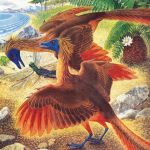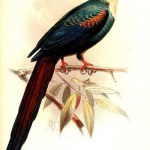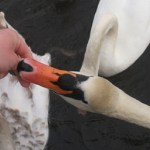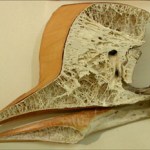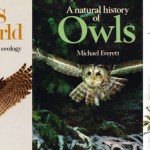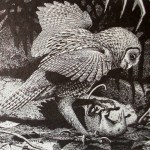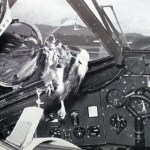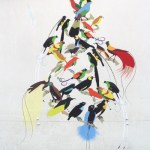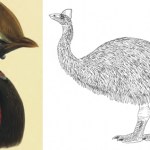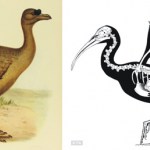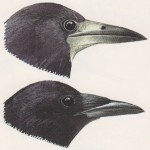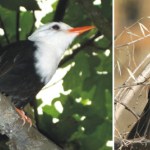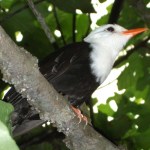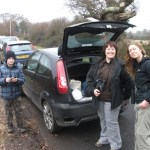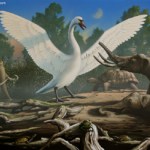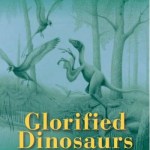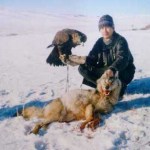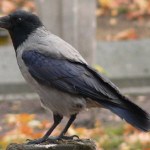ornithology
There are over 10,000 species of bird on the Earth today. There is one blog called "10,000 Birds" for which I write a monthly article, in case you did not know. But this post is about Ten Thousand Birds: Ornithology Since Darwin, a book by Tim Birkhead, Jo Wimpenny and Bob Monegomerie.
Birds and various studies of birds are central to evolutionary theory and the development of all of the surrounding biology and science. Here's a short list of key roles birds have played in evolutionary biology:
Darwin's study of pigeon breeding was central to On the Origin of Species and later works.
The…
Yet more from that book project (see the owl article for the back-story, and the hornbill article for another of the book's sections).
Hornbills, hoopoes and woodhoopoes are all similar in appearance and have been classified together in a group termed Bucerotes. Vague similarities with other long-billed, forest-dwelling birds (like woodpeckers, long-billed cuckoos and such passerines as tree-creepers) meant that early ornithologists were often confused about the affinities of these birds. By the late 1800s, however, most had realised that all three were close relatives, and that they were…
Suppose you're interested in the anatomy and biology of ground hornbills. Now suppose that you get the chance to make physical contact with one of these awesome birds. Here, at last, is the opportunity to get bitten!! Surely you've always wanted to know what it feels like when a ground hornbill bites you. No? Ok, maybe it's just me. Anyway, the opportunity to get bitten by a ground hornbill presented itself to me a few weeks ago, so who was I to miss out?
As I can now confirm from personal experience, it turns out that ground hornbills don't bite hard enough to hurt. My impression is that…
More from the bird book. For the back-story, see the previous owls article.
Hornbills are among the most distinctive and spectacular of Old World tropical birds. Often flaunting bright colours and sometimes reaching huge sizes (the largest species have wingspans of 1.8 m), they're well known for their enormous, curved bills and large bony crests. [Image above shows Great Indian hornbill skeleton Buceros bicornis (l) and male Wreathed hornbill Rhyticeros undulatus (r) (by Blijdorp, from wikipedia). Hornbills like the Great Indian hornbill are forest-dwelling omnivores that eat fruit as well…
There's something they don't tell you about freelance writing. It's about all the fails: the many, many projects that get pitched, worked on and made into proper presentations that then get sent to book fairs, interested companies and so on, but ultimately explode on the launch pad, or die a slow, lingering death. I don't know if it's that I'm especially unlucky, or if it's that I've pitched an unusually high number of books, or if it's that I've genuinely worked on a high number of projects that were never destined to succeed but, whatever, I've now worked on loads of failed book projects.…
Here's something you don't see very often...
This illustration (by Peter Trusler) shows the large Pleistocene Cuban owl Ornimegalonyx oteroi battling with a solenodon. Ornimegalonyx has been mentioned here a few times before (use the search bar), but nothing substantive, sorry. Most sources mention O. oteroi as if it's the only named species of Ornimegalonyx. Actually, Arredondo (1982) named three additional ones: O. minor, O. gigas and O. acevedoi. And, by the way, the Ornimegalonyx owls weren't the only big owls on Pleistocene Cuba - there was also a particularly big eagle owl (Bubo…
I've long had a special interest in the sleeping habits of small birds. In fact, as you'll know if you read the article I published here back in September 2008*, I've covered this issue before. In that article, I noted that at least some passerines secrete themselves away in crevices or thick foliage. I first became really interested in this subject after making one of my greatest natural history 'discoveries': a sleeping Blue tit Cyanistes caeruleus that I encountered while it was tucked deep beneath the broken bark of a tree, just the tip of its tail betraying its presence. I didn't have…
It's a sad fact of life that, as long as there are aircraft, and as long as there are birds, there will be collisions between aircraft and birds. I did in fact cover the issue of bird-strikes back in January 2008, but since then I've learnt a few new things that I'd like to share.
For the record, I'm not covering this issue - or featuring the various photos you see here - because I regard it as at all amusing or frivolous; quite the contrary. As I said in the 2008 article, bird-strikes pose a serious hazard to aircraft, most typically during landing and takeoff, and they also result in…
I love seeing tetrapod-themed art, especially in unexpected places. While in London recently I noticed this 'tropical bird' painting on a piece of wooden boarding, erected to conceal building work. As you can see (larger version below), the work is mostly a brilliant montage of birds-of-paradise (properly Paradisaeidae), the remarkable resplendent "rainforest crows in fancy dress"* of New Guinea and its surrounds.
* Sherman Suter, 1998.
I'd prefer it if it was birds-of-paradise only, but it also features a few parrots (right at the top) and a Great blue turaco Corythaeola cristata too. The…
I have a great liking for cassowaries, and I've had good reason to write about them several times. I've also had fun playing with preserved specimens and skeletons - something I must elaborate on at some time. Back in 2006 - the days of Tet Zoo ver 1 - I blogged some of my cassowary-related musings, and in the interests of both recycling and of getting credit for stuff I've already gotten credit for before, I repost them here. Partly due to laziness, I never did include the article you're about to read - some say one of my all-time greatest articles ever - in the book Tetrapod Zoology Book…
Time to finish one of those long-running series of Tet Zoo articles: at last, the long-awaited, much anticipated third and final instalment in the series on the clubs, spurs, spikes and claws present on the hands of numerous neornithine bird species. If you haven't done so already, do check out the previous parts here (on hand claws in general, and carpal spurs and knobs in waterfowl) and here (on carpal spurs in charadriiforms).
Those previous instalments looked at claws (widely present in modern birds: far from unique to the Hoatzin Opisthocomus hoazin) and at keratin-sheathed bony knobs…
I love turkeys, and here I specifically mean the so-called Wild turkey Meleagris gallopavo and its domestic variants, not the Ocellated turkey M. ocellata (though - don't get me wrong, Ocellated turkeys are great too). Herewith a brief look into the world of turkeys (part of it recycled from Tet Zoo ver 1)... involving a brief excursion on motmots and rooks. I was going to finish up on the whole pterosaur reproduction thing, but I can't. I'll explain why soon enough. [Composite below incorporates images from wikipedia and an original at far right].
Like so many birds, turkeys are…
I've just heard the tragic and saddening news that ornithologist Bradley Livezey died yesterday morning (Tuesday 8th February, 2011) following a car crash. It seems that his car lost traction due to snow and ice on the road surface and then collided with another vehicle. Brad was 56. I never met him, but regarded him as a very friendly and co-operative correspondent.
Brad was a leading ornithologist, based at the Carnegie Museum of Natural History. After receiving a bachelor's degree at Oregon State University in 1976, he was awarded a master of science degree at the University of Wisconsin-…
One of my long-running plans on Tet Zoo has been to review passerine phylogeny. After decades of people saying that oscine passerines are (except larks and corvids) far too alike for anyone to construct a sensible phylogeny, a flurry of (mostly molecular) studies have meant that - as I like to say - the passerine tree is finally coming together. Alas, I'm nowhere near able to review current hypotheses of passerine evolution in depth (and didn't I say something recently about not starting any new major Tet Zoo projects?).
Well done to those of you who correctly identified the 'mystery' bird…
Please identify. If possible, make it more interesting by saying something about the animal's behaviour, ecology and/or phylogenetic position (believe me, there is plenty to say). As usual, a smug sense of self-satisfaction to the winner.
The big buzz here in Hampshire (southern England) at the moment is the recent arrival of a White-tailed eagle Haliaeetus albicilla. This magnificent raptor - it can have a wingspan of 2.4 m and is one of the biggest eagles in the world - is historically extinct in England, but individuals still appear here on occasion [image of the Hampshire bird shown here by Darren Crain].
A member of the 'sea eagle' clade Haliaeetus, the White-tailed eagle appears to be the sister-species of North America's only sea eagle, the Bald eagle H. leucocephalus (Wink et al. 1996, Lerner & Mindell 2005).…
It's well known that the islands of the Mediterranean were formerly home to an assortment of island endemics, all of which are now extinct. Most of the best known ones are mammals like pygmy elephants, pygmy hippos, pygmy megacerine deer and giant dormice, but there were also large birds, tortoises and lizards. My excellent friend Bob Nicholls of www.paleocreations.com has been kind enough to share this wonderful piece of art, featuring extinct and extant animals of Pleistocene Malta (close-ups below the fold). It's used with permission and is © Robert Nicholls.
One thing I particularly…
I read a lot of books in 2010, and mostly enjoyed all of them. Among my favourites was Luis Chiappe's Glorified Dinosaurs: The Origin and Early Evolution of Birds, and in the lengthy review article below (currently in press for Historical Biology) you can find what I thought of it. Note that Glorified Dinosaurs is not especially new (it appeared in 2007): it typically takes a few years for lengthy written reviews of large books to see completion (or, ha, it does in my case anyway).
One more thing to note: some of what I say here (e.g., about the relationship between birds and other…
No time for anything new (err, just a tad busy at the moment), so here's something else from the Tet Zoo archives. This article originally appeared on ver 1 in April 2006 and appears here in slightly modified form.
In previous articles we've looked at the ability of large eagles - the Golden eagle Aquila chrysaetos in particular - to kill surprisingly large prey. As in adult pronghorn, adult reindeer, juvenile red deer and juvenile domestic cattle etc. (see links below, or Cooper (1969), Deblinger & Alldredge (1996) and Nybakk et al. (1999)). Such behaviour isn't unique to Golden eagles…
When you discover something new on the internet, you usually find - minutes or hours later - that everyone else already knows about it, and you're just late to the party. And so it is here. But what the hell. Petya Cosmos recently alerted me to this hilarious, and interesting, video. The drama, the suspense, the sheer, epic scale of what unfolds, the music from Predator... make sure you have the volume turned up loud... [NB - only watch the video if you can have the sound on too].
Maybe it's just me, but I found the video hilarious (and brilliantly edited). Then again, I always did find cats…
